By John McLean
PREFACE
This document has been written in response to the independent review of the Intergovernmental Panel on Climate Change (IPCC) currently being undertaken by the InterAcademy Council (IAC).
Others may have a different opinion but I have no faith whatsoever in this review because the IAC has far too many close links with the International Science Union (ICSU), an organization that spent almost 30 years pressuring for the creation of the IPCC (see chapter 1).
According to the IAC website, the 18-member board of the IAC has at least three people - Ralph Cicerone, Martin Rees and Kurt Lambeck - who head national science bodies, all of which are members of the ICSU. Howard Alper, also an IAC board member, is the co-chair of IAP, the global network of science academies, and most of those academies are ICSU members. Membership of the ICSU has the documented obligation of supporting its objectives, which means that already the IAC’s independence is compromised.
The relationship is not merely via overlapping roles of individuals and the bodies they represent because the president of the ICSU is an official observer on the IAC board, and among the IAC’s web links to “partner organizations” we find the ICSU listed prominently.
The IAC and ICSU have a very similar role. Both seek to fit the square peg of science into the round hole of politics, to take a field where truth is not determined by consensus and twist it to fit a field where consensus is everything. Both have grandiose statements of intent - the IAC’s is “Mobilizing the world’s best science to advise decision-makers on issues of global concern” - and both work very closely with UN bodies such as the UNEP, a co-sponsor of the IPCC.
The ICSU’s modus operandi is to involve government and intergovernmental organizations in research projects where those organizations provide funding and ICSU members do the observations and research. The ICSU writes a report about that work and presents it to the client organization although rarely with any external peer-review.
The IAC makes similar statements about its work; in fact the IAC seems almost a twin of the ICSU in that it seeks to provide scientific input to governments and intergovernmental organizations and does so via reports.
The close links between the IAC, the ICSU and United Nations bodies like the UNEP make me think it very unlikely that the IAC review of the IPCC will propose radical changes because to do so would be to alienate a number of organizations and put its future work prospects at risk. So carefully does it need to tread that I expect only recommendations for minor changes rather than the radical changes that I believe are necessary.
Rather than make a submission to review that is at risk, in my eyes, of being perhaps not a whitewash but nonetheless weak, I have elected to release my own views on the matter via a different forum.
The first chapter of this review will deal at length with the scientific justification for the establishment of the IPCC, which is not as solid as some might believe, by exploring the events, reports, individuals and organizations that played key roles.
Chapter two will show that the writing of IPCC Assessment Reports is a process open to bias by the authors, consensus about the text is far less than the IPCC implies and how IPCC authors have rallied together to produce papers for citing by the reports.
Chapter three will deal with the peer-review process and explain its fundamental flaw and show how it is nothing more than a means of soliciting further information to support the IPCC’s arguments.
The fourth chapter will discuss the IPCC’s distortions and serious omissions, the kinds of things that if published in unbiased fashion would have undermined its strident claims.
Chapter five will present the case that the IPCC’s temperature data is unreliable and that the method of temperature measurement, the environment in which that monitoring takes place, the coverage of the Earth’s surface and even the sources of the data are so dynamic as to cast doubt on the accuracy of the entire temperature record.
Chapter six will show that the climate models on which the IPCC relies for attribution and projection are seriously flawed because, as the IPCC indirectly states, they are incomplete.
Chapter seven will provide a short summary of the key problems with the IPCC’s analysis of climate issues and show that the IPCC’s claim of significant man made warming cannot be sustained.
The final chapter contains some brief recommendations for a climate monitoring and investigation system with far greater integrity than the IPCC has shown.
Because this is a review, examples will be provided where applicable. It should not be assumed that the examples are the only instances of problems related to the subject matter under discussion, nor that the authors and reviewers mentioned were the only people to act in a similar fashion.
When examining the IPCC reports my focus has been the contribution by Working Group I because the contributions by the other working groups are based on the assumption that WGI correctly describes the situation. For this reason I don’t address matters such as plagiarism on the matter of Himalayan glaciers nor the citing of very suspect material in discussion of the Amazon rainforest and changes in the Antarctic.
Finally, let me state for the record that none of the work for this review was funded by anyone other than myself.
CHAPTER 1 – THE DUBIOUS SCIENTIFIC JUSTIFICATION FOR ESTABLISHING THE IPCC
INTRODUCTION
To properly understand how the IPCC grew to hold so much influence it is necessary to examine the relevant events and actions that led to its establishment and to then focus on the key players, the individuals and organizations who firstly drove its creation and then its power.
The casual observer might believe that the United Nations Environment Programme (UNEP) and the World Meteorological Organization (WMO) decided in the late nineteen-eighties to form a joint-venture to consider climate matters but in reality the pressure for the IPCC or some similar organization started building almost 20 years earlier and was driven by the beliefs of individuals, by politics and, very likely, opportunism. Exaggeration of claims, various deceitful omissions and a glossed-over desperate shortage of scientific understanding played their part, but so too did the environmental “blame human beings for everything” zeitgeist of the time.
See full analysis here.
By Indur M. Goklany
Background
Based on 2000-08 data, extreme weather events are responsible for about 0.05% of all global deaths (31,700 deaths vs. 58.8 million, annually). That is, despite the media attention to such events, extreme weather events have a minor impact on global public health.
Long term (1900-2008) data show that average annual deaths and death rates from all such events declined by 93% and 98%, respectively, since cresting in the 1920s (Figure 1). These declines occurred despite a vast increase in the populations at risk and more complete coverage of extreme weather events (Figure 2).
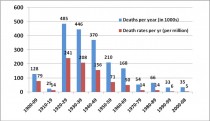
Figure 1: Enlarged here. Global Death and Death Rates Due to Extreme Weather Events, 1900-2008. Source: Goklany (2009), based on EM-DAT (2009), McEvedy and Jones (1978), and WRI (2009).
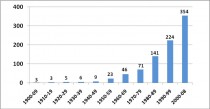
Figure 2: Enlarged here. Average Number of Extreme Weather Events per Year by Decade, 1900-2008. Source: Goklany (2009), based on EM-DAT (2009).
Deaths and death rates from droughts were responsible for the majority (58%) of all deaths due to extreme weather events from 1900-2008. They also peaked in the 1920s. Since then, they have been reduced by 99.97% and 99.99%, respectively (Figure 3).
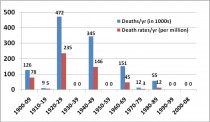
Figure 3: Enlarged here. Droughts: Global Deaths & Death Rates, 1900-2008. Source: Goklany (2009), based on EM-DAT (2009), McEvedy and Jones (1978), and WRI (2009).
For floods, responsible for another 34% of aggregate deaths, deaths and death rates have declined by 98.7%-99.6% since the 1930s (Figure 1).
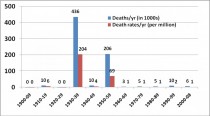
Figure 4: Enlarged here. Floods: Global Deaths and Death Rates, 1900-2008. Source: Goklany (2009), based on EM-DAT (2009), McEvedy and Jones (1978), and WRI (2009).
For storms (including hurricanes, cyclones, tornados, typhoons), responsible for 7% of extreme weather event deaths from 1900–2008, deaths and death rates declined by 47.0%-70.4% since the 1970s (Figure 4).
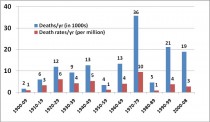
Figure 5: Enlarged here. Storms (including hurricanes, cyclones, tornados, typhoons): Global Deaths and Death Rates, 1900-2008. Source: Goklany (2009), based on EM-DAT (2009), McEvedy and Jones (1978), and WRI (2009).
These trends indicate that the total risk of death from all extreme weather events has actually declined despite claims that the number and intensity of extreme weather events has increased. The decline in deaths from extreme weather events occurred despite an increase in deaths from all causes, indicating that the world is coping with the former much better than it is with far more significant sources of deaths and disease. What accounts for the reduction in the death toll from extreme weather events?
First, the decline in the death toll from droughts, in particular, is that global food production has never been higher than it is today (Goklany 1998, 2007). This is largely due to improved seeds, fertilizers, pesticides, irrigation, and farm machinery. This entire suite of technologies also enabled the Green Revolution. But fertilizers and pesticides are manufactured from fossil fuels, and energy is necessary to run irrigation pumps and machinery. Without them, the benefits of improved seeds would be for naught. And in today’s world, like it or not, energy for the most part is synonymous with fossil fuels.
The resulting increase in yields and food production helped reduce food prices worldwide which reduced hunger by making food more affordable (Goklany 2007). Additional CO2 in the atmosphere has also contributed to higher yields and food production (IPCC 2001: 254–257, 285) because it provides carbon, the basic building block of life, and also increases the efficiency with which plants use water helping offset declines in water availability, if any.
Another factor critical to reining food prices and reducing hunger worldwide is trade within and between countries which enables food surpluses to be moved to food deficit areas (Goklany 1995, 1998). But it takes fossil fuels to move food around in the quantities and the speed necessary for such trade to be an integral part of the global food system, as it indeed is. Moreover, fossil fuel dependant technologies such as refrigeration, rapid transport, and plastic packaging, ensure that more of the crop that is produced is actually eaten by the consumer. That is, they increase the overall efficiency of the food production system, which helps lower food prices and contain hunger worldwide.
The second important factor is better disaster preparedness, and more rapid response and delivery of humanitarian aid when disaster strikes. Timely preparations and response are major factors that have contributed to the reduction in death and disease that traditionally were caused by or accompanied disasters from extreme weather events (Goklany 2007b). Their success hinges on the availability of fossil fuels to move people, food, medicine and critical humanitarian supplies before and after events strike. Economic development also allowed the US (and other developed countries) to offer humanitarian aid to developing countries in times of famine, drought, floods, cyclones, and other natural disasters, weather related or not. Such aid, too, would have been virtually impossible to deliver in large quantities or in a timely fashion absent fossil fuel fired transportation.
These improvements, which occurred despite increases in the populations at risk, can be attributed largely to the combination of greater economic development and technological change. Together they enable society to protect against - and cope with - adversity in general, and extreme weather events in particular (IPCC 1991; Goklany 1995, 2007).
The role of economic development in reducing the death toll from natural disasters is confirmed by analyses undertaken by Kahn (2005) and van der Vink et al. (2007). Kahn’s analysis of natural disasters for 73 nations from 1980-2002 found that an average nation with a population of 100 million and GDP per capita of $2,000 would in 1990 have experienced 944 deaths from natural disaster, however, had GDP per capita been raised to $14,000, its death toll would have fallen to 180 per year, an 81% decline (p. 280). Although both studies covered weather and non-weather related disasters, their findings should be generally applicable to all types of natural disasters, whether weather related (or not). Both also found that nations that were less democratic and scored lower on measures of good governance suffered a higher death toll. Kahn also concluded that greater income inequality led to higher death tolls.
These findings are generally consistent with recent experience on natural disasters. For instance, while no two disasters are alike in terms of risk and population exposure, it is notable that an estimated 222,600 people died in the 7.0 magnitude Haiti earthquake in January 2010, while the death toll from the much-stronger 8.8 magnitude Chilean earthquake that occurred the following month killed fewer than 600 people (EM-DAT 2010). Similarly, in 2008, Cyclone Nargis, with a maximum intensity of 115 knots, killed 138,400 in Myanmar while Cyclone Sidr - maximum intensity, 140 knots - killed 4,240 in Bangladesh (JWTC 2007, 2008; EM-DAT 2010).
Finally, over the long term, despite population increases, cumulative mortality from extreme weather events has declined globally, even as total (all-cause) mortality continues to increase. That is, humanity is coping better with extreme weather events than with far more important health and safety problems.
Resources spent to reduce global warming are better spent elsewhere
Currently many advocate spending trillions of dollars to reduce anthropogenic greenhouse gases, in part to forestall hypothetical future increases in mortality from global warming induced increases in extreme weather events. Spending even a fraction of such sums on the numerous higher priority health and safety problems plaguing humanity would provide greater returns for human well-being (Goklany 2009a, 2009b). No less important, efforts to reduce greenhouse gas emissions would slow, if not retard, economic development and/or make fossil fuels scarcer and more expensive thereby militating against the very factors that have reduced deaths and death rates from extreme weather events.
Summary
Whether the magnitude or frequency of extreme weather events has increased because of global warming is not evident from long term data on deaths and death rates from extreme weather events. In any case this issue is secondary to the fact that casualties from all such events have been reduced by over an order of magnitude in the past decades. These reductions are due in large part to factors that contribute to greenhouse gas emissions.
Reducing these emissions through efforts to make fossil fuel energy scarcer and more expensive could, therefore, be counterproductive in humanity’s efforts to limit death and disease from not only such events but also other, far more significant sources of adversity.
About the author
Dr. Indur M. Goklany is a member of the GWPF Academic Advisory Council. He is an author and a researcher who has been associated with the Intergovernmental Panel on Climate Change since its inception in 1988 as an author, expert reviewer, and U.S. delegate to that organization.
New Zealand Coalition
The High Court has been asked to invalidate the New Zealand official temperature record (NZTR) as promoted by the Crown Research Institute, NIWA. These records are the historical base of NIWA’s scientific advice to central and local government on issues relating to climate change. NIWA maintains temperature archives for the past century, and also projects them forward for the next century.
The statement of claim filed on behalf of the New Zealand Climate Science Education Trust (NZCSET) asks the court for three rulings:
A: to set aside NIWA’s decisions to rely upon its Seven Station Series (7SS) and Eleven Station Series (11SS), and to find the current NZTR to be invalid
B: to prevent NIWA from using the current NZTR (or information originally derived from it) for the purpose of advice to any governmental authority or to the public
C: to require NIWA to produce a full and accurate NZTR.
‘’Twentieth-century temperature records are now being challenged all around the world” said Bryan Leyland, spokesman for the NZCSET. “But I think we are the first country where the issues are to be placed squarely before an independent judicial forum.”
“Many scientists believe that, although the earth has been in a natural warming phase for the past 150 years, it has not heated as much as Government archives claim. The precise trend figure is extremely important, as it forms the sole basis of the claim that human activities are the dominant cause of the warming.
“The New Zealand Met Service record shows no warming during the last century, but NIWA has adopted a series of invariably downward adjustments in the period prior to World War 2. Because these move the old temperature records downwards, the 7SS NZTR shows a huge bounce-back of over 1°C in the first half of the century” said Mr Leyland. “Although this is out of line with dozens of other records, and has been the subject of sustained questioning by both the New Zealand Climate Science Coalition and the ACT party, NIWA refuses to accept that there are serious problems with the adjustments. In fact, no one has been able to explain exactly how they were arrived at.”
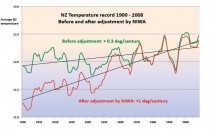
Enlarged here.
The Court proceedings also allege bias and unethical conduct on the part of NIWA’s National Climate Centre. These are based partly on NIWA allegedly delegating the NZTR decision to a former employee, James Salinger, knowing that he had a vested interest in an untested theory put forward in his own 1981 thesis. NIWA also knew that the data and calculations for that theory had been lost, and, thus could not be replicated.
Another core criticism is NIWA’s constant reliance on an eleven-station series it produced last December. The flaws in this paper have been highlighted many times, including at
http://www.quadrant.org.au/blogs/doomed-planet/2010/06/nz-climate-crisis-gets-worse
“We find it hard to believe NIWA management just failed to notice that all the warming in the ‘eleven-station’ series was caused by the fact that it starts off with only three stations in 1931. From 1945 onwards there are between 9 and 11 stations” said Mr Leyland, “It’s astonishing how the increasing number of stations leads to greater warming, more alarm, and increased research grants.”
The Court will be asked to rule that NIWA has refused to repudiate the current NZTR in order to avoid political embarrassment, and feared loss of public confidence in the objectivity of its scientists. The proceedings were filed and served this week, and NIWA has up to a month to respond.
If successful. will be the precedent to go after the other data centers for their advocacy and deriliction of duty.


